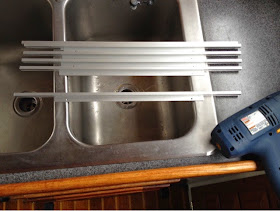Back in October, I re-designed the curtain tracks on two of our aft ports in order to allow them to open more completely. The results were so nice and professional looking that the remaining six ports just begged to be upgraded too. So I ordered more curtain track from Sailrite.
This last weekend I got around to making the installations. But because there were six to do, a little manufacturing engineering came into play.
First, at home I cut and trimmed the track with my trusty hacksaw and vice. Then I set up a work station at the galley sink for drilling - the sink traps the drill swarf and keeps it off the floor where it would damage the finish. Above, you can see that I have marked where the holes go on the tracks and am busy drilling them with a 5/32" bit.
After finishing the manufacture of the tracks, the work fell naturally (that is, unplanned...) into four workstations, each with its own dedicated tools:
And then move on to the next port...
Tho having these four stations pretty much occupied the whole boat during the work, it completely eliminated all movement of tools except for the small handful used at Station 1. For me this is a huge advantage, since otherwise I am always looking for one tool or another.
It took all afternoon, but only one beer.
This last weekend I got around to making the installations. But because there were six to do, a little manufacturing engineering came into play.
First, at home I cut and trimmed the track with my trusty hacksaw and vice. Then I set up a work station at the galley sink for drilling - the sink traps the drill swarf and keeps it off the floor where it would damage the finish. Above, you can see that I have marked where the holes go on the tracks and am busy drilling them with a 5/32" bit.
After finishing the manufacture of the tracks, the work fell naturally (that is, unplanned...) into four workstations, each with its own dedicated tools:
- Station 1: At the current port. Tools here were a #2 Phillips screwdriver, a 3/8" box wrench, a small flat blade screwdriver, and a small #1 Phillips screwdriver.
- Station 2: The galley sink. Tools here were the drill, water and a sponge
- Station 3: The saloon table. Tools here were Meguires plastic cleaner, Meguires plastic polish, and some rags
- Station 4: The saloon settee. Tools here were a #2 Phillips screwdriver and a 5/16" nut driver.
- At Station 1:
- Remove the existing curtain track and curtains from the rusty spring clips and set aside
- Using the #2 Phillips and the 3/8" wrench, remove the nuts and screws holding the port hinges together.
- Remove the port lens.
- At Station 2:
- Carefully wash the port lens using water and the sponge.
- Transfer the hole locations from the track to the port lens and mark with a Sharpie.
- Drill two 5/32" holes.
- At Station 3:
- Apply polish to the inside of the lens and turn it over
- Apply cleaner to the outside and rub vigorously to remove the oxidized lexan.
- Remove the cleaner with a rag and apply polish to the outside of the lens
- Buff the outside of the lens.
- Buff the inside of the lens.
- At Station 4:
- Now that the lens is clean, it won't dirty the settee cushion, and it needs protection. Working on the settee is perfect. Install the track to the lens with two 6-32 screws and nylock nuts, using the #2 Phillips and the nut driver.
- Back at Station 1:
- Insert the lens hinge plates into the hinge plates on the port frame.
- Use the small Phillips screwdriver to align the holes. It is perfect for this - the shaft is exactly the right diameter and the tapered tip allows easier alignment. I struggled mightily with this step before I stumbled across the use of the screwdriver.
- Insert the screws into the hinges and add the nuts.
- Using the small flat blade screwdriver, remove the stop screws from the ends of the old track.
- Remove the curtains from the old track.
- Install the curtains into the new track.
- Install the stop screws in the ends of the new track.
And then move on to the next port...
Tho having these four stations pretty much occupied the whole boat during the work, it completely eliminated all movement of tools except for the small handful used at Station 1. For me this is a huge advantage, since otherwise I am always looking for one tool or another.
It took all afternoon, but only one beer.



